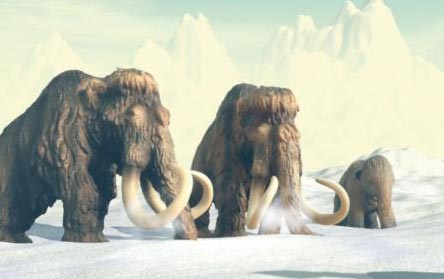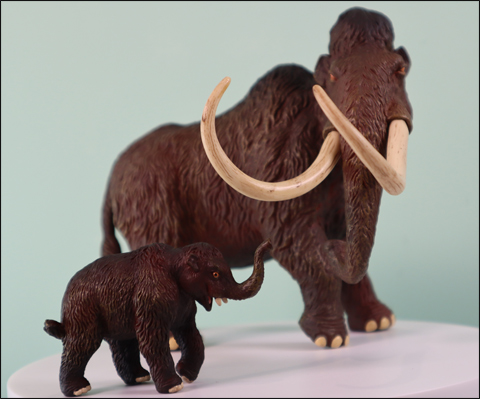Dramatic Climate Change Led to Demise of the Woolly Mammoth
New research published in the scientific journal “The Quaternary Science Review” by a team of British based scientists suggests that dramatic global climate change led to the demise of mega fauna such as the Woolly Mammoth and not predation by humans.
Researchers from the University of Durham in collaboration with scientists at the London Natural History Museum have concluded that by 11,400 years ago, most of the large mammals that had roamed across the Northern Hemisphere, animals such as the Giant Elk (Megaloceras), the Woolly Rhino and the Woolly Mammoth had become extinct. Although hunting from the rapidly expanding human population may have had an effect, the loss of extensive areas of grassland and the re-forestation of northern Europe and Asia was the real reason for these animals extinction.
Woolly Mammoth
Our ancestors would have competed with these large mammals for space and food but it was sudden and dramatic climate change that led to the demise of most of the mega fauna at this time the scientists conclude.
Their findings are part of the most comprehensive study carried out so far on climate change and its impact on the flora and fauna of the northern hemisphere after the height of the last Ice Age, 21,000 years ago.
A rapid and sustained period of post-glacial global warming led to a rapid decline in open grasslands as much of northern Europe and Asia became woodland and forest. Although Mammoths were descended from forest dwelling elephants, the rapid change in habitat was just too quick to enable these large, shaggy elephants to adapt. The climate changes that led to the change in the landscape and its flora made survival impossible for the big grazing herbivores and the predators that fed on them.
Although Woolly Mammoths are often depicted in icy, glacial environments these elephants were animals of the open plain and fed on grasses, sedges and other ground dwelling plants. The loss of their habitat led to their demise, claim the research team.
An Illustration of a Family of Woolly Mammoths

Picture credit: Schleich
To view a model of Woolly Mammoth and dinosaur toys: Papo Prehistoric Animal Models and Dinosaurs.
Over the last two or three years, there have been a number of papers published, assessing the impact of global climate change on mammal populations. Perhaps this is a reflection of the concerns expressed over the problem of dramatic climate change that threatens our own species. Last year, we reported on some research work that set out to accurately date some Mammoth fossils that had been found in Shropshire, England, using radiocarbon dating.
To read more about radiocarbon dating work on Mammoth fossils: Radiocarbon dating changes date of Mammoth Extinction.
The Last Refuge of Woolly Mammoths
One of the principal authors of the study, Professor Brian Huntley of the School of Biological and Biomedical Sciences (Durham University) stated:
“Woolly Mammoths retreated to northern Siberia, 14,000 years ago, whereas they had roamed and munched their way across many parts of Europe, including the UK , for the previous 100,000 years.”
Commenting on the suggestion that our ancestors may have been at least partially responsible for the Mammoth’s extinction, Professor Huntley said:
“It would have been difficult for man to wipe them out [Woolly Mammoths] because our species was not so widespread then and did not have the technology. We know from Mammoth fossils that they were hunted by humans, but they would not have been an easy kill because of their size.”
The British based research team point the finger at rising temperatures, the factor that led to the extinction of animals as diverse as Woolly Rhinos, the Mammoths, giant deer and the large meat-eaters that preyed on them.
Although some small, isolated pockets of animals may have clung on for a little longer, the climate change and loss of habitat that resulted had effectively sealed the fate of these species the scientists conclude.
A Replica of an Adult Woolly Mammoth and Calf

The CollectA Deluxe Woolly Mammoth model in 1:20 scale and the CollectA Prehistoric Life Woolly Mammoth calf.
Picture credit: Everything Dinosaur
Summarising the study, Professor Huntley stated:
“Mega-mammals found it increasingly difficult to find food. We believe the loss of food supplies from productive grasslands was the major contributing factor to extinction.”






Leave A Comment